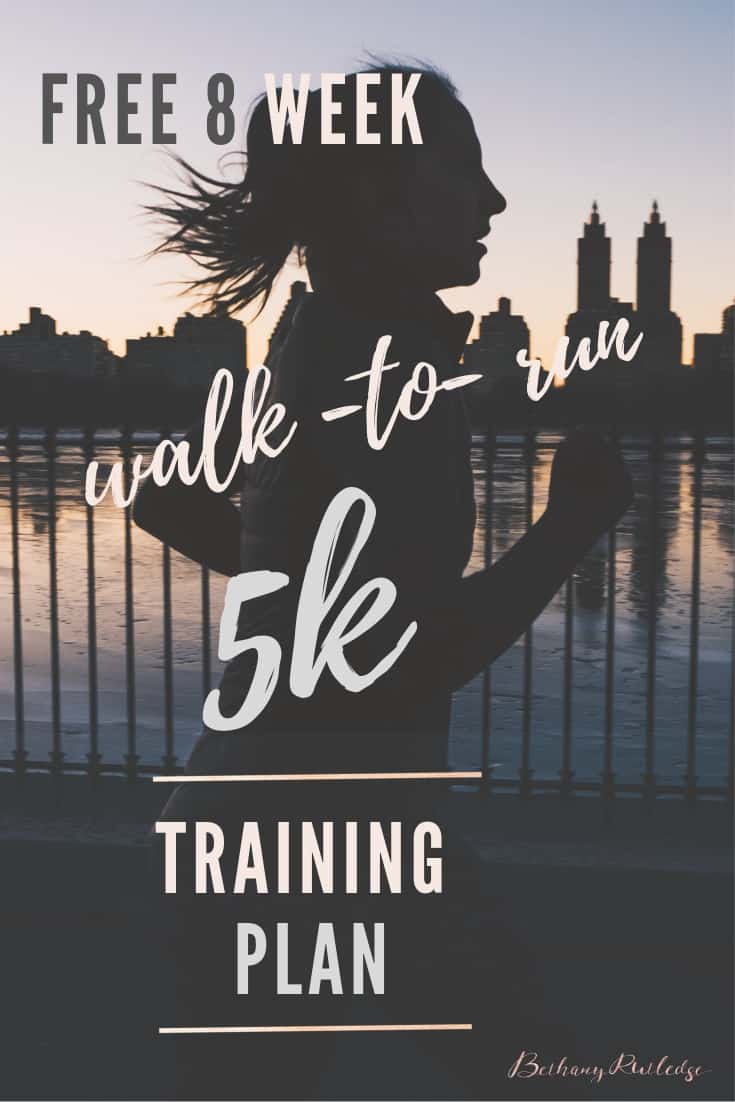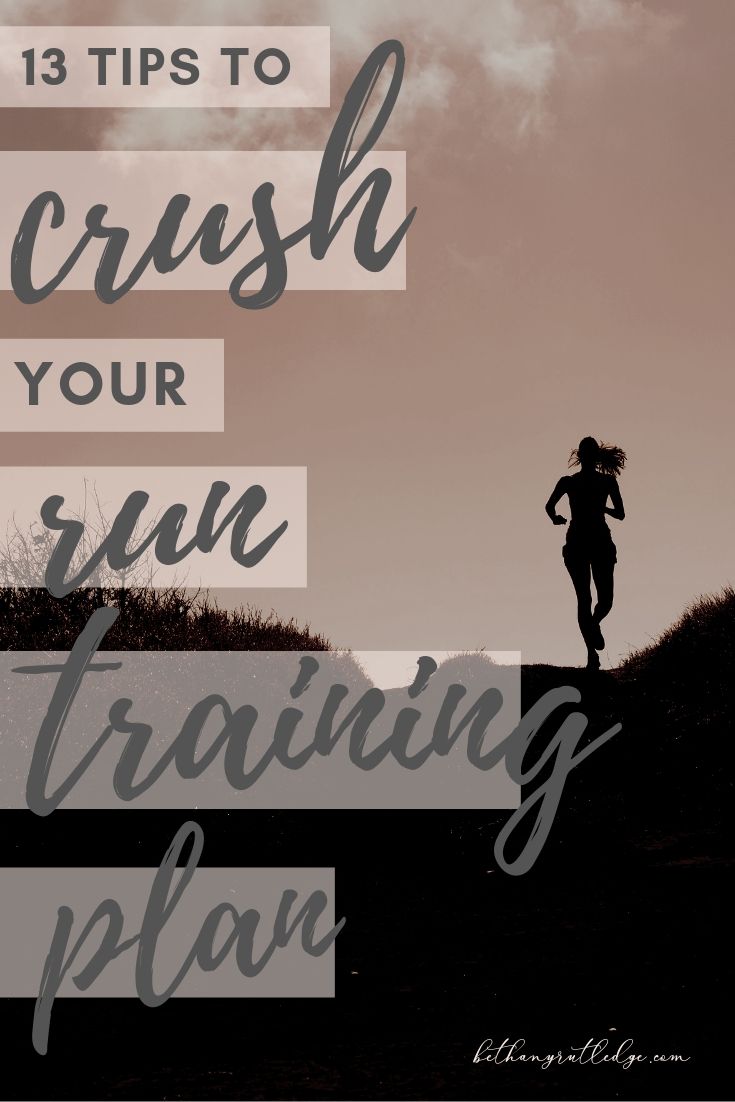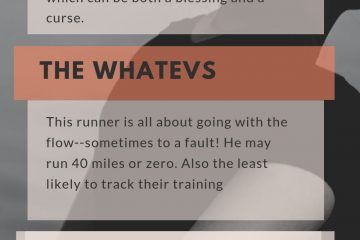13 tips to nail your beginner run training plan

Worried about following your beginner run training plan successfully? Here are thirteen must-know tips to crush your beginner run training.
When I first started running, I didn’t follow a beginner run training plan, but I had them. When I was younger, I went through intermittent spurts of running. I couldn’t seem to get motivated to run consistently. In fact, I dreaded every plodding step.
In fact, I had several to compare to make sure I was doing enough. I printed them out; I logged my training on beginnertriathlete.com; I talked about them with my new fitness buddies.
Basically I had a training plan but I wasn’t having it work for me. Another common issue is exactly the opposite– you feel like a slave to your training program and a failure if you don’t follow it to the letter.
Neither situation is idea. So let’s talk about the thirteen ways to ROCK your run training plan.

Top 13 ways to rock your beginner run training plan
The term training plan sounds self-important and vaguely frightening. Some think of a training plan as having magical powers. Or maybe that was just me. Here are a few common dos and don’ts as you dive into to your training plan.
1. Set an appropriate timeline for your event
For the purposes of this article, we’ll assume that you’re training for an actual event.
Life can foil or complicate your training timeline, and injury, illness, or extended travel can’t always be predicted.
If you have no health barriers and have been cleared by your physician, you are ready to start.
And if you’re in decent physical condition, already exercising in the three sports, then consider training for an event ten to sixteen weeks out. Planning something six months from now that’s achievable in a few weeks may not be an exciting enough carrot.
Haven’t picked your event yet? Be sure to pick up my guide to picking your first race. Just tell me where to send it:
2. Start with a plan on your level
Where should you start? If you’ve been sedentary for the last six months, begin with a couch to 5K program before training for a triathlon.
If you’re new to training and racing a new distance (like a marathon) then the goal for the first one should be to finish and you shouldn’t get overly attached to a specific time goal
Need a beginner 5k training plan to get started? Be sure to grab a copy. Just click below and tell me where to send it.

3. Don’t Skip the Skill Work.
Your plan will likely include guidelines for warmup, cooldown, and ancillary exercises. Don’t skip these!
Running and cycling with no attention to skill can also reinforce poor habits. You may still get faster initially because you’re doing the sport more, but eventually poor form and lack of skill will become a limiter.
Instead, incorporate skill work into your training from the outset. Swimming is the most important sport to gain instruction. When my husband and I started training, this was one of the first and best tips we received. Though it was tempting to skip professional instruction, I have no doubt that it helped us in the long run. In fact, if I could go back, I would commit to more swim instruction before training the swim. Once you firm up that muscle memory, it’s very hard to change habits.
4. Don’t add to the schedule
Since overtraining is a clinical syndrome and can be misleading, we’ll call the issue “training more than appropriate” or “under-recovery.” Many beginners (again, lacking a plan) want to train their favorite sport at the detriment of their area of opportunity.
For example, if you’re used to running daily, you may need to temporarily cut back to allow space for swim and bike. Using a plan will give you an idea of a balanced way to disperse your time and energy over the disciplines.
5. Do log what you actually do
Whether it’s marking off a printed plan, or using an online training software like Strava or TrainingPeaks, commit to tracking your training. You need data to objectively assess your fitness. Perhaps you missed a week of training due to illness, and you’re wondering whether you have enough fitness to take on your next race. Your past data gives you or your coach context to make these decisions.
It’s too easy to misremember if you’re not logging daily. How so? Our memories are fallible and typical memories of training are rife with hyperbole. “I used to run twenty miles a week,” someone might say, then a peek at their training log reveals they ran twenty miles for one week back in 2010. Why does it matter? Because instead of someday wondering how you were possibly able to run so far or so much, you’ll be able to fact check yourself for a more accurate picture.
Let’s say your best running year ever was 2014. What were you doing then? What kind of mileage, volume, and intensity made you so fast? Having history takes out the guesswork.

6. Use the plan as a guide not law
I’m going to let you in on a little secret. When you’re brand new, your number one priority is to build up the endurance to successfully get from the start line to the finish line safely. That’s it.
You don’t need the fancy run intervals your fast friend told you about. You don’t even actually do 100 percent of what’s on the plan. Following a basic plan takes away the guesswork, the worry. Am I doing too much, too little, not enough? Is there anybody out there training the same as I am?
7. Leverage the principles of training
Let’s talk about the principles that are at the heart of every training plan. At the most basic level, a training plan is a simple map to take you from where you are to where you want to be. And if you’re using a training plan in this book, one you find online, or the one your friend recommended—unless it’s written for you alone—it’s a more general plan that may need some tweaking to fit you best.
In order to bring positive change, physical stress to the body is necessary, and its actually during recovery that we become stronger. This response is called adaption. Increasing the stress or stimulus to create further adaption is called progressive overload, and it is at the heart of every training plan. The three elements of training: workout frequency, workout duration, and workout intensity are manipulated to create more or less stress.
Frequency—How often you work out is the most basic element of training. For example, your training plan may have you swim two to three times/week, bike two to three times/week, and run two to four times/week.
Duration—Duration can be measured in terms of the distance covered or the elapsed time of the workout. Some workouts are long to build greater endurance, while others are short to allow more emphasis on higher intensities or to promote recovery. Your training plan will measure swim duration in yards, run duration by time, and cycling duration by time.
Intensity—Intensity is the measure of how hard you are working. Unlike frequency and duration, workout intensity is somewhat more difficult to quantify. The beginner training plan in this book uses RPE (rate of perceived exertion) to measure intensity.
8. Set your heart rate zones With lactate threshold
Setting zones requires an anchor point. Without a reference point, “zone two” doesn’t mean anything. Zone two of what? To populate heart rate zones, we first need to know your lactic threshold heart rate.
For heart rate to mean anything, you require a northern star, and that star is your lactic threshold heart rate. Lactate threshold (LT) refers to a point physiologically where lactate starts accumulating in the blood more quickly than it can be processed. The heart rate value that corresponds is called lactate threshold heart rate (LTHR).
If you look at any forum where new triathletes gather, there is still a lot of confusion over the use of heart rate and the proper use of zones. With the mainstream availability of wrist heart rate sensors in everything from Apple Watch to Garmin, more and more people have access to using heart rate, but sometimes that access lacks context. Thus, it is not unusual to hear athletes claiming to do all their runs in zone 5, perform three-hour rides at an IF of 1.2, or other impossible feats.
Instead of hitting an exercise physiology lab, most amateur athletes use field tests to find this value. During the test you will perform an all-out 30-minute effort. The average heart rate of the last twenty minutes of that effort is about your LTHR . Your running LT and cycling LT are not the same and should be tested separately. At Energy Lab, we use Joe Friel’s HR training zones (see the Triathlete Training Bible by Joe Friel) which are based on your lactate threshold heart rate (LTHR). If you use heart rate in training or intend to, testing is of the utmost importance; 220 minus age is not a reliable way to set zones, nor are the default settings in Garmin Connect. Using those values will only serve to confuse and frustrate you.
9. Retest zones regularly
As an intermediate or experienced athlete, one of the first things you will do in the training plan is test in all three sports. In some cases, it may not be appropriate to test right away in all three sports, for example, if you just started running or have an injury. After testing, your workouts will be communicated in zones.
Simple Run and Bike LTHR Test:
- Perform an easy 10-minute warm-up.
- Perform a 30-minute time trial, capturing your heart rate average for the last 20 minutes.
- Input that value into TrainingPeaks or other online calculator or use the following chart to find your values.
Your running and cycling heart rate thresholds will be different values, so be sure to do both tests!
| Heart Rate Zones | |
| Running Zones | |
| Zone 1 | Less than 85% of LTHR |
| Zone 2 | 85 to 89% of LTHR |
| Zone 3 | 90 to 94% of LTHR |
| Zone 4 | 95 to 99% of LTHR |
| Zone 5a | 100 to 102% of LTHR |
| Zone 5b | 103 to 106% of LTHR |
| Zone 5c | More than 106% of LTHR |
| Cycling Zones | |
| Zone 1 | Less than 81% of LTHR |
| Zone 2 | 81 to 89% of LTHR |
| Zone 3 | 90 to 93% of LTHR |
| Zone 4 | 94 to 99% of LTHR |
| Zone 5a | 100 to 102% of LTHR |
| Zone 5b | 103 to 106% LTHR |
| Zone 5c | More than 106% of LTHR |
10. Periodize your training
Periodization simply means dividing your beginner run training plan into chunks and focusing each period on different aspects of fitness. Each section will look different in terms of frequency, intensity, and volume of the three sports. As your goal race approaches, your training will move from general (less like the race) to specific (more like the race).
For our purposes, periodization needn’t be complicated. For absolute beginner athletes, the most important factor is developing the endurance to get to the finish line while building volume safely with appropriate recovery periods.

11. Take setbacks in stride
The goal? Checking off each day’s session with no barriers, interruptions, or setbacks. The reality? Things often don’t go as planned. Don’t become discouraged when inevitable setbacks occur. The following things happen to everyone:
- Something hurts.
- Work, family, or life gets in the way.
- You or a family member gets sick.
- You temporarily lose motivation.
It’s what you do next that determines your ultimate success. After a setback, rekindle your motivation by remembering what inspired you in the first place.
12. Take breaks into consideration
What happens if I miss a few days?
- If you miss a couple of days to one week of training, then take a few easy ramp-up days and continue into the current week on the plan.
- If you miss more than five days of training, you may need a longer period of reduced training/ramp-up to get back on track.
- Whatever
you do, do not try to make up all the missed sessions. You can rearrange future
sessions if you miss a few priority workouts (long workouts), but don’t try to
cram everything in or you could injure yourself!

13. Don’t push through at all costs
What if I am too tired to complete a session?
There will inevitably be days where you have trouble completing a session as prescribed. This is completely normal. You have a couple of choices: you can shuffle around workouts, skip it, or try to revisit the workout later.
Your key sessions in the beginner run training plan are your long runs. If you miss a key session, do your best to fit it in when you are well rested and have the time to tackle that session, even if it means dropping or rearranging something else.
Now it’s your turn
What are your best tips for following–and sticking to–a beginner run training plan? How do you get and stay motivated to run? I’d love to hear! Please leave me a comment below.
Looking for courage to try something new? I’m here for that. Join 1470 others for a mostly-weekly dose of mojo.

Hi, I’m Bethany–coach, author of Courage to Tri, 2x Kona qualifier, and twin mom. Helping writers grow online presence to spread their message in a digital world.
Free guide: cross your first finish line in 2019
P.S. If you’re still having trouble getting motivated to run, then check out this video!
Next up: 5 ways to really improve your running.
Other ideas for your fitness journey:
- How to start running at age 40,50, 60 and beyond
- Protected: Training notes for your first sprint triathlon
- Conquering Triathlon Swimming Training
- What is the worst new runner mistake?
- Ultimate guide to planning your first sprint triathlon
Like this idea? Pin it!




8 Comments
Sydney · June 11, 2019 at 7:40 pm
I am not a beginner but these tips can help anyone!!! Thanks for sharing such great info! I’ll be saving this post!
Shayla Thiessen · June 12, 2019 at 3:14 am
This is such amazing post! A great resource for people just beginning, like I am. I am leaving this open on my browser to return to as I need it!
Should I Run by Pace or Heart Rate? — Bethany Rutledge · June 1, 2019 at 2:31 pm
[…] Now you can use your newly corrected HR zones while following a training plan. […]
How to [finally] make running a habit — Bethany Rutledge · June 3, 2019 at 6:39 pm
[…] See: Nail your 5k training plan […]
Essential Running Gear for Women l 2019 — Bethany Rutledge · June 4, 2019 at 8:31 pm
[…] See: Tips to crush your run training plan […]
Top eleven beginner running tips you need to knoow — Bethany Rutledge · June 5, 2019 at 7:45 pm
[…] a run training plan and recording your mileage in a training log is important for all […]
Marathon Training for Beginners l 2019 — Bethany Rutledge · June 9, 2019 at 7:40 pm
[…] See: Run training plan tips […]
How to start running at age 40 and beyond — Bethany Rutledge · June 24, 2019 at 3:20 pm
[…] After you download your plan, be sure to check out best ways to rock your run training plan. […]
Comments are closed.